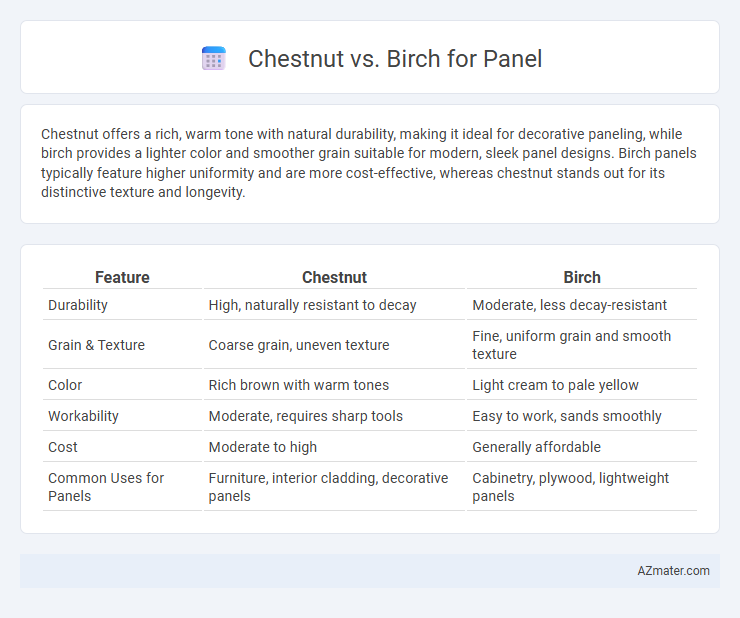Chestnut offers a rich, warm tone with natural durability, making it ideal for decorative paneling, while birch provides a lighter color and smoother grain suitable for modern, sleek panel designs. Birch panels typically feature higher uniformity and are more cost-effective, whereas chestnut stands out for its distinctive texture and longevity.
Table of Comparison
| Feature | Chestnut | Birch |
|---|---|---|
| Durability | High, naturally resistant to decay | Moderate, less decay-resistant |
| Grain & Texture | Coarse grain, uneven texture | Fine, uniform grain and smooth texture |
| Color | Rich brown with warm tones | Light cream to pale yellow |
| Workability | Moderate, requires sharp tools | Easy to work, sands smoothly |
| Cost | Moderate to high | Generally affordable |
| Common Uses for Panels | Furniture, interior cladding, decorative panels | Cabinetry, plywood, lightweight panels |
Introduction to Chestnut and Birch Wood
Chestnut wood is valued for its durability, fine grain, and warm, golden-brown hue, making it a popular choice for decorative panels and furniture. Birch wood features a smooth texture with a pale, creamy color and excellent strength, often used for interior paneling and cabinetry. Both woods offer distinct aesthetic and structural qualities suitable for different design preferences and applications.
Botanical and Historical Background
Chestnut (Castanea spp.) and Birch (Betula spp.) are hardwoods with distinct botanical traits; Chestnut trees belong to the Fagaceae family, known for their spiny burs and large, serrated leaves, while Birch trees are part of the Betulaceae family, characterized by their smooth, papery bark and triangular leaves. Historically, chestnut wood was prized in Europe and North America for its durability and resistance to decay, commonly used in construction and furniture until the chestnut blight reduced its availability; birch has been valued for its fine grain and light color, frequently utilized in plywood, veneers, and traditional crafts across northern temperate regions. Both woods offer unique aesthetic and functional qualities for panel applications, with chestnut providing robust strength and rich texture, and birch delivering a smooth finish and versatility.
Appearance and Grain Patterns
Chestnut panels showcase warm, rich reddish-brown hues with distinct, bold grain patterns that highlight natural variations and knots, offering a rustic and traditional aesthetic. Birch panels reveal lighter, creamy tones with fine, even grains and subtle waves, creating a smooth, modern appearance ideal for minimalist designs. The pronounced texture of chestnut contrasts with birch's uniformity, influencing the overall look and feel of interior spaces.
Hardness and Durability
Chestnut wood, with a Janka hardness rating of approximately 540, tends to be softer than birch, which scores around 1260, making birch significantly harder and more resistant to dents and scratches. Birch panels also exhibit superior durability, resisting wear and moisture better than chestnut, which can be more susceptible to damage over time. For applications requiring long-lasting and robust paneling, birch is the preferred choice due to its greater hardness and durability.
Workability and Machinability
Chestnut offers moderate workability with a coarse grain that can challenge fine detailing but machines relatively well with sharp tools, making it suitable for rustic panels. Birch provides superior workability and excellent machinability due to its fine, uniform texture, allowing for smooth finishes and intricate designs in paneling. Both hardwoods respond well to sanding and finishing, but birch's consistent grain reduces the risk of tear-out during cutting and shaping.
Cost and Availability
Chestnut panels typically cost more than birch due to their unique grain patterns and slower growth rate, limiting supply. Birch is more widely available, sourced sustainably in large quantities, making it a cost-effective option for paneling projects. The price difference between chestnut and birch panels can significantly impact project budgets depending on local availability and market demand.
Environmental Impact and Sustainability
Chestnut wood offers superior environmental advantages over birch due to its faster growth rate and greater carbon sequestration capacity, making it a more sustainable choice for panel production. While birch panels are durable, chestnut's natural resistance to decay reduces the need for chemical treatments, lowering overall ecological impact. Sourcing chestnut from responsibly managed forests ensures renewable material supply, reinforcing its role in eco-friendly construction and interior design.
Common Applications in Paneling
Chestnut panels are commonly used in interior wall cladding and decorative ceiling treatments due to their warm color and natural grain patterns that enhance rustic and classic design aesthetics. Birch panels, favored for their light color and fine, uniform texture, are extensively applied in modern cabinetry, furniture surfaces, and architectural millwork where a sleek, contemporary look is desired. Both wood types offer durability and workability, but chestnut is preferred for traditional paneling projects, while birch suits applications requiring smooth finishes and paintability.
Pros and Cons
Chestnut panels offer excellent durability and natural resistance to decay, making them ideal for high-moisture environments; their rich, warm tones add a rustic charm but can be more expensive and harder to source sustainably. Birch panels provide a smooth, light finish suitable for modern or minimalist designs and are generally more affordable and readily available, yet they may lack the hardness and moisture resistance of chestnut. Choosing between chestnut and birch depends on balancing budget, aesthetic preference, and the environmental conditions where the panel will be installed.
Choosing the Right Wood for Your Project
Chestnut offers a warm, rich tone with excellent durability and resistance to decay, making it ideal for rustic paneling in both interior and exterior projects. Birch provides a lighter color and a smooth, consistent grain suitable for modern and minimalist panel designs requiring easy staining and finishing. Selecting between chestnut and birch depends on desired aesthetics, environmental exposure, and project budget, with chestnut favored for strength and longevity and birch for cost-effectiveness and versatility.

Infographic: Chestnut vs Birch for Panel
 azmater.com
azmater.com